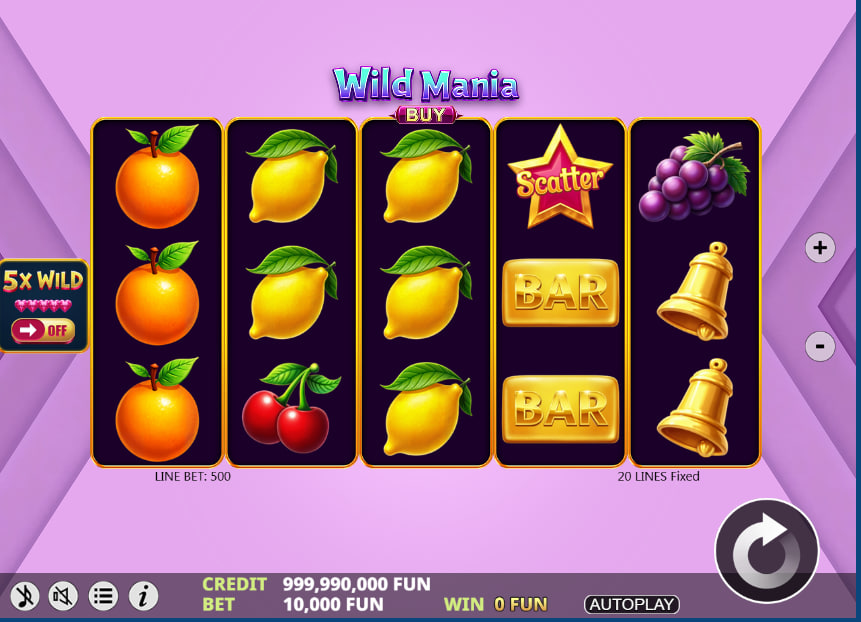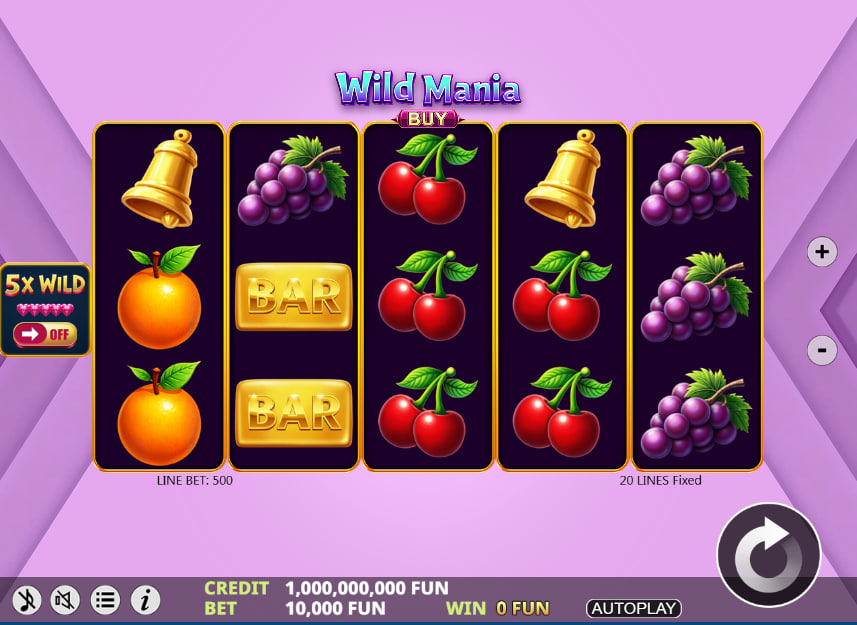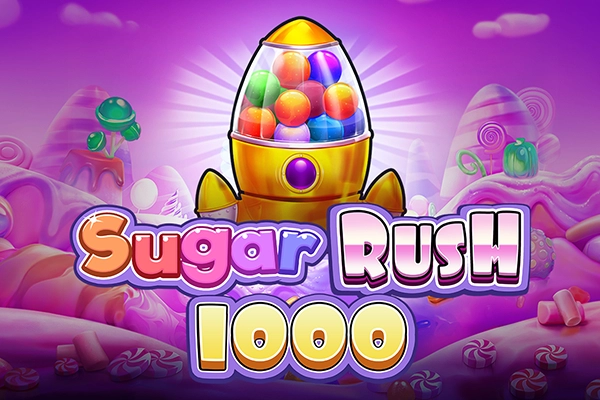Wild Mania Buy by Excellent Reel combines a classic fruit machine theme with modern player-controlled mechanics. The game presents a clean, high-definition aesthetic on a standard 5×3 grid with 20 fixed paylines. Its core design centers on two significant optional features that alter the gameplay dynamics. Players can activate a “5X WILD” side bet to increase the potential of every spin or use the “BUY” function for immediate access to the game’s main bonus event. With a stated RTP of 96.15%, the base game operates at a medium volatility level. However, engaging the special features allows players to directly manipulate the risk and reward structure of their session. This design prioritizes mechanical depth and player agency over complex narrative elements. Ultimately, Wild Mania Buy functions as a versatile slot instrument for experienced players.
Excellent Reel's Wild Mania Buy presents an interesting case study in modern slot design. At first glance, it adheres strictly to the classic fruit machine template, utilizing a familiar cast of symbols rendered in a clean, contemporary style. However, embedded within this conventional framework are two distinct gameplay-altering mechanics—a “BUY” feature and a “5X WILD” side bet—that fundamentally shift the game from a traditional reel-spinner into a system that offers significant player agency over the session's pacing and volatility. This review will provide a detailed examination of these systems, the underlying game mechanics, and the overall design philosophy at play.

The Core Modifiers: Dissecting the ‘BUY' and ‘5X WILD' Options
The defining characteristics of Wild Mania Buy are not its theme or its standard payline structure, but the two prominent, optional mechanics that grant the player direct control over core gameplay events. These features are not merely additions; they represent a different approach to session management and are clearly aimed at a player who is familiar with such systems and understands the associated cost-benefit dynamics.
The most conspicuous of these is the large ‘BUY’ button positioned above the reels. In the absence of a dedicated free spins round explicitly detailed in the rules, this button aligns with the now-common “Bonus Buy” function seen across the industry. This type of feature typically provides immediate entry into the game's main bonus event for a fixed, upfront cost, usually calculated as a multiple of the current total bet. Given that the Scatter symbol is the only special symbol without a direct interactive feature attached, it is the logical trigger for whatever event the BUY button initiates. For the player, this function serves as a method to bypass the base game entirely, circumventing the standard process of landing three or more Scatters organically. The strategic implication is clear: it’s a high-cost, high-potential maneuver designed for those who wish to focus exclusively on the game's most dynamic phase.
Operating on a different principle is the ‘5X WILD’ side bet, controlled by a toggle on the left side of the screen. This is not a one-time purchase but a persistent bet modification that, when activated, alters the conditions of every subsequent spin. The name itself suggests a potent enhancement to the Wild symbol's function. While the precise mechanism isn't fully detailed on the main interface, such a feature typically either adds a set number of Wild symbols to the reel strips, significantly increasing the probability of their appearance, or applies a 5x multiplier to any payline win that includes a Wild. Given the phrasing, the former seems more probable. Activating this side bet invariably increases the total cost per spin, turning it into a tool for injecting higher volatility into the base game itself. It’s an aggressive option that directly trades a higher cost-per-spin for an increased frequency of high-value symbol combinations.
Aesthetic and Auditory Design
Wild Mania Buy consciously avoids thematic complexity. Its presentation is built on a foundation of lucid, high-definition graphics applied to a classic symbol set. This is not a nostalgic throwback attempting to replicate the look of a physical machine from decades past; rather, it is a modernization of that aesthetic. The fruit symbols—cherries, lemons, oranges, and grapes—are rendered with a glossy, almost candy-like sheen, giving them a tangible and visually appealing quality. The higher-value symbols, such as the golden Bells and BARs, are polished and reflective, while the Pink 7 is designed with a sharp, crystalline look.
The animation is functional and serves to punctuate gameplay events rather than distract from them. Winning paylines are clearly highlighted, with the participating symbols receiving a subtle pulse or shimmer. The expectation is that more significant win events or feature triggers would be accompanied by more energetic visual feedback, but the base game remains visually clean. The background is a simple, geometric pattern in muted tones, a deliberate choice that forces the player's attention onto the reels where the core action happens. This minimalist approach suggests a design philosophy that prioritizes mechanical clarity above all else. The game isn't trying to build a narrative or an immersive world; it is built to be a clear and direct gaming instrument.
The sound design is expected to follow a similar path. The auditory experience in such slots typically consists of synthesized reel-stop sounds, distinct jingles for different tiers of wins, and a more pronounced musical score during a bonus feature. This functional approach to sound complements the visual design, ensuring that the player receives clear feedback without unnecessary auditory clutter. It’s a design that respects the player's focus on the mechanics of the game.
A Study in Slot Mechanics and Payout Structure
Beneath the optional feature layers, Wild Mania Buy operates on a solid and familiar mechanical base. The game is configured with a 5-reel, 3-row grid and utilizes 20 fixed paylines. This structure is an industry standard, providing a predictable canvas for the game's symbol combinations to form. Payouts are awarded for combinations landing from left to right on adjacent reels, starting from the first reel, a rule that is standard for most video slots.
The symbol paytable is structured with a clear hierarchy, which is essential for player understanding of win potential on any given spin.
Premium Symbol: The Pink 7 stands alone at the top of the paytable, offering the highest potential line win.
Scatter Symbol: The Star symbol acts as the Scatter. Its primary value is its ability to pay out regardless of its position on the paylines. Getting three or more Scatters anywhere in view constitutes a win, which is multiplied by the total bet, not the line bet. This is also the symbol most likely linked to the main feature trigger.
High-Tier Symbols: The Bell and the BAR symbol form the upper-middle tier of the payout structure.
Low-Tier Symbols: The Grapes, Orange, Lemon, and Cherries constitute the lower-value symbols, designed to provide more frequent, smaller wins.
An interesting detail within this structure is that the Cherry symbol awards a payout for a 2-of-a-kind combination, while all other standard symbols require a minimum of three. This is a subtle but important piece of design inherited from classic slot machines. It slightly increases the hit frequency of the game, providing small returns more often and breaking up streaks of non-winning spins.
The Wild symbol, represented by a pink heart-shaped gem, carries the crucial function of substitution. It can stand in for any other symbol except the Scatter to complete a winning line. A key strategic limitation is its appearance only on reels 2, 3, 4, and 5. This placement means the Wild can never initiate a winning combination on its own from the first reel; its role is strictly to help connect or extend combinations that have already started. This is a critical balancing factor, especially when considering the potential impact of the ‘5X WILD' side bet.

Volatility, RTP, and Developer Philosophy
The game’s technical specifications provide a mathematical context for the gameplay. Wild Mania Buy is listed with a medium volatility and a theoretical Return to Player (RTP) of 96.15%. An RTP of 96.15% is competitive and sits comfortably within the range that experienced players generally find acceptable. It represents the theoretical percentage of all wagered money that the slot will pay back to players over a very long period of play.
The “medium volatility” designation is perhaps the most interesting specification, as it likely applies only to the base game when played without any of the optional features activated. In this state, the game should deliver a balanced experience, with a steady mix of small, medium, and occasional large wins. However, this baked-in volatility is completely altered by player choice. Engaging the ‘BUY' feature is an inherently high-volatility action, risking a large flat cost for a chance at a substantial return. Similarly, activating the ‘5X WILD' side bet fundamentally increases the volatility of every single spin, raising both the cost and the potential for very large line hits. The game effectively contains three distinct volatility profiles: the baseline medium volatility, a high-volatility profile with the side bet active, and the session-defining high-risk/high-reward spikes of the feature buy.
This multi-layered approach to volatility and player choice appears to be central to the philosophy of the provider, Excellent Reel. With Wild Mania Buy, they have constructed a hybrid game. It leverages the instant recognition and simplicity of a classic fruit theme to create a comfortable foundation, but then builds upon it with modern mechanics that cater to a more aggressive and strategy-conscious player. The game feels less like a singular experience and more like a versatile toolset, allowing players to tailor the pace and risk level of their session to their own preferences. The decision to play it as a straightforward medium-variance slot or to engage its more potent and costly features rests entirely with the user.













